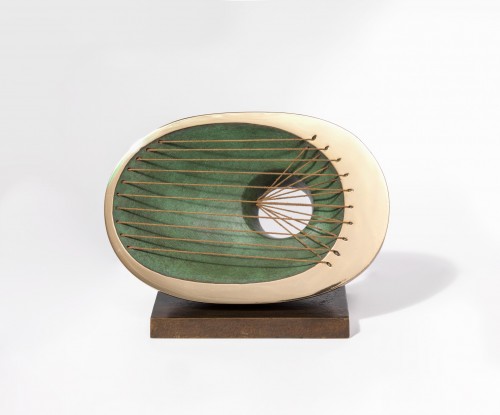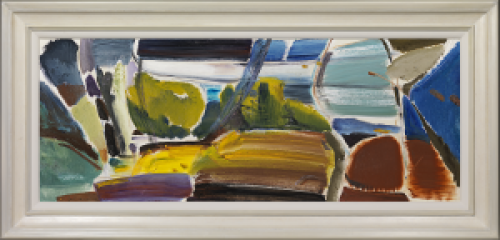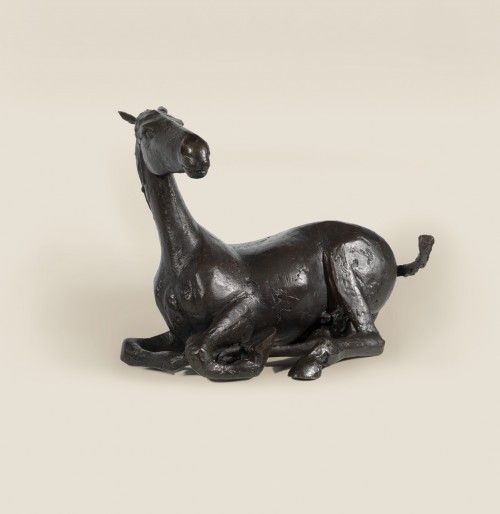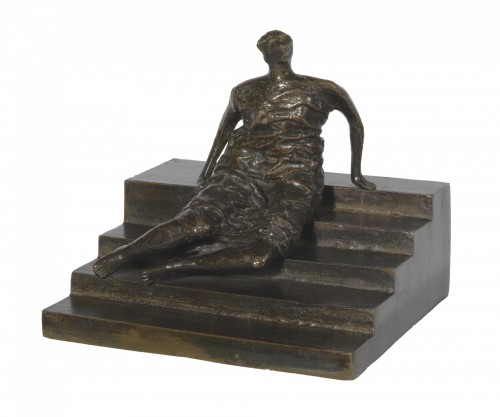HENRY MOORE
Castleford 1898 - 1986 Much Hadham
Ref: BR 53
Maquette for a Draped reclining woman
Bronze: 5 ½ x 8 x 4 ¾ in / 14 x 20.3 x 12.1 cm
Conceived in plaster and cast circa 1956 by Fiorini, London, in an unnumbered edition of 9+1
LH 429
On its original table base
Provenance:
The artist
M Knoedler and Co., New York, 4th February 1957
Joseph H Hirshhorn, New York, 1966
The Hirshhorn Museum and Sculpture Garden, Washington DC
Sotheby’s New York, 19th November 1986, lot 217, sold to benefit the acquisitions program
New Art Centre, London
Waddington Galleries, London, by 1992
Barbara Lambrecht, acquired from the above in 1995, sold to benefit the Rubens Prize Collection in the Museum of Contemporary Art in Siegen
Exhibited:
Washington DC, Hirshhorn Museum and Sculpture Garden, The Smithsonian Institution, Henry Moore: The Hirshhorn Museum and Sculpture Garden Collection, 28th July – 22nd September 1978, no.39
New York, Potsdam State University of New York, Brainerd Art Gallery, The Benefactors Solomon R Guggenheim, Joseph H Hirshhorn, Roy R Neuberger, 19th October – 9th November 1980
London, Waddington Galleries, Sculpture, April-May 1992, no.26
London, Waddington Galleries, Henry Moore, June-July 1992, no.24
Literature:
Alan Bowness (ed.), Henry Moore, Complete Sculpture, Vol. 3, 1955-1964, Lund Humphries, London, 1965 (reprinted 2005), no.429, p.35, another cast illus. p.34
John Hedgecoe, A monumental vision, Cologne, 2005, no.392, another cast illus. p.223
The present work is a maquette for the larger than life-sized, Draped reclining woman, 1957-8 [LH 431], made in an edition of 6 (plus two artist’s copies), casts of which are in the collections of the Sainsbury Centre for Visual Arts, University of East Anglia, Norwich; the Tate; the Bayerische Staatsgemäldesammlungen, Munich; the Staatsgalerie, Stuttgart; and the Norton Simon Museum of Art, Pasadena.
During the mid-1950s a series of public commissions (including a monumental sculpture for the UNESCO headquarters in Paris) inspired Moore to explore the integration of figurative sculpture in an architectural setting. As a result he created a group of drawings and maquettes which feature draped figures seated on or against geometric architectural elements such as benches and steps. While the setting of the seated figure was a departure for Moore, the draped figure recalled an interest apparent in his earlier shelter drawings. Moore’s interest was revitalised by his visit to Greece in 1951, inspiring a return to the study of drapery and its importance in the revelation of form: ‘Drapery can emphasise the tension in a figure, for where the form pushes outwards, such as on the shoulders, the thighs, the breasts, etc., it can be pulled tight across the form (almost like a bandage), and by contrast with the crumpled slackness of the drapery which lies between the salient points, the pressure from inside is intensified.’[1] Moore’s first draped figure conceived in bronze was the Reclining figure commissioned for the Time-Life building in 1952–53, during which he developed a technique that undoubtedly informed the modelling of diaphanous material represented here: ‘gradually I evolved a treatment that exploited the fluidity of plaster. The treatment of drapery in my stone carvings was a matter of large, simple creases and folds but the modelling technique enabled me to build up large forms with a host of small crinklings and ruckings of the fabric.’[2]
The seventh child of Raymond Spencer and Mary Moore, Henry was born in Castleford, Yorkshire in 1898. His paternal great-grandfather was of Irish origin, but his father and grandfather were born in Yorkshire where, for two or three generations, they worked the land or went down the mines. At the age of twelve Moore obtained a grant to study at the Grammar School in Castleford where he was inspired by his art teacher to pursue a career in the arts. In 1916 he began to teach, but by February 1917 he had joined the army and left to fight in
France. After being wounded in action in November 1917 at the battle of Cambrai, Moore was excused from active service. He returned to England, where he became a physical education instructor in the army.
At the end of the war, Moore received a veteran’s grant to study at Leeds School of Art and in 1921 he joined a course at the Royal College of Art in London. A further grant enabled him to travel extensively from 1925, visiting Rome, Florence, Venice, Ravenna and Paris, where he met Picasso, Giacometti, Ernst, Eluard and Breton among others. On returning from his travels Moore was appointed Professor of Sculpture at the Royal College of Art where he worked two days a week until 1931, as well as teaching at the Chelsea School of Art until 1939. He was appointed an Official War Artist during the Second World War from 1940–1942 for which he made a series of drawings of people sheltering in the London Underground, as well as studies of miners at the coal face. In these pictures he frequently used watercolour over wax crayon.
After the war Moore enjoyed a great deal of success, with his works receiving critical acclaim all around the world. He executed many major commissions for museums, public institutions, private collectors and municipal buildings and as a result he became one of the most famous British artists of the twentieth century. At the beginning of the 1970s Moore created a foundation, the aim of which was to promote public awareness of sculpture and to protect his own work for the future. Located in his home village of Much Hadham, Hertfordshire, the foundation houses a library, archives and a collection of drawings, prints, maquettes and sculptures by the artist. Heavily influenced by the work of Michelangelo, Moore created monumental works in marble, stone and bronze and was enthralled by the theme of the family, and in particular the mother and child. His unique oeuvre draws inspiration from prehistoric, archaic, Egyptian, African, Mexican and Roman sculpture. Throughout his career he was noted for his output of graphic art – drawings, watercolours, etchings and lithographs which were not necessarily related to individual sculptures.
[1] The artist cited in Philip James, Henry Moore on Sculpture, MacDonald, London, 1966, p.231.
[2] Ibid., p.230.
























